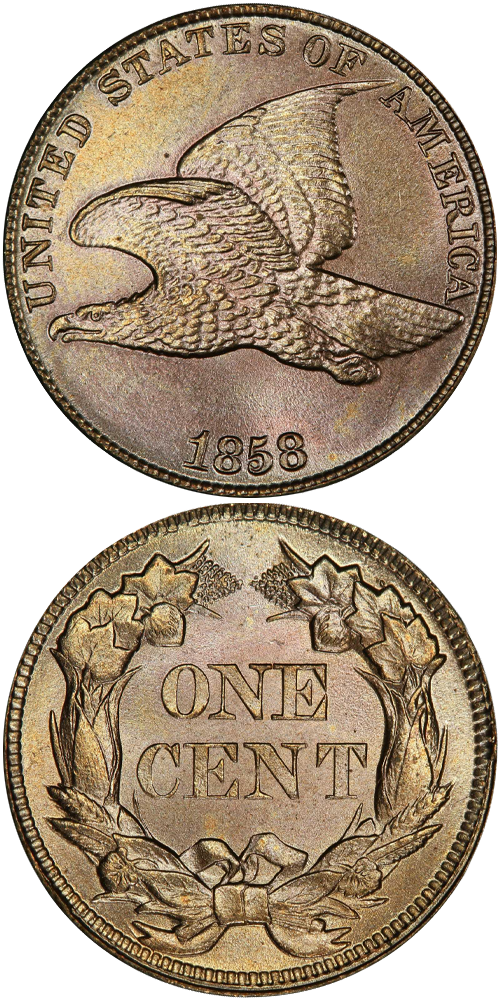1858 Flying Eagle Cent
Large Letters
Circulation Strike:
On May 25, 1857, when the new small cent was introduced into everyday use, a temporary booth was set up on the Mint's grounds to exchange old large cents and half cents as well as the recently demonetized foreign silver coins, mostly in the form of Spanish colonial reales in various denominations. The changeover from the old large cents of days past to the new smaller Flying Eagle cents was a resounding success; lines of people went around the block waiting to exchange their coins. Soon the old large cents, familiar since childhood, were driven from daily use, along with the foreign silver coinage.
Production of the smaller cents was stepped up from 17,450,000 pieces in 1857 to 24,600,000 the following year using dies prepared from two slightly but distinctly different obverse hubs. The first of these hubs - the Large Letters obverse - was originally used in 1857 and is most easily distinguishable from the later hub in that the letters AM in AMERICA are joined at their bases, while the second Small Letters hub has these two letters clearly separated. The Large Letters variety seems to have been produced in marginally larger quantities, though both have long been popular among cent specialists. Longacre's graceful interpretation of the Peale-Gobrecht eagle design from 20 years earlier proved to have some fundamental deficiencies that caused problems in production as well as in circulation. Because of the way the eagle was situated in relation to the cereal wreath on the reverse combined with the relatively high relief of the design, the coins are usually found softly struck, causing an overall lack of details even in Mint State. Attempts to rectify the problem proved inconsistent, prompting Mint officials to quickly replace the entire design for 1859.
Even though all 1858 Flying Eagle Cents are readily available in most grades up through Choice Mint State, finding an especially well struck example is particularly challenging. This is especially so for the Large Letters coins, as there are very few at the Gem level of preservation.
Proof Strike:
According to Rick Snow in the 2014 edition of his Flying Eagle and Indian Cent Attribution Guide:
The estimated mintage of 100 [for the Proof 1858 Flying Eagle cent] is derived from the 80 silver sets reportedly sold plus a small mintage of pattern sets, no more than 20. The number of survivors seems to fit these figures, and serve as a reasonable starting point. I would estimate that about 50 examples exist today.
View 1858 Large Letters Flying Eagle Cent Auction Results
The example to the left was sold by Stack's Bowers Galleries in January 2013 Sale, where it realized $28,200.






